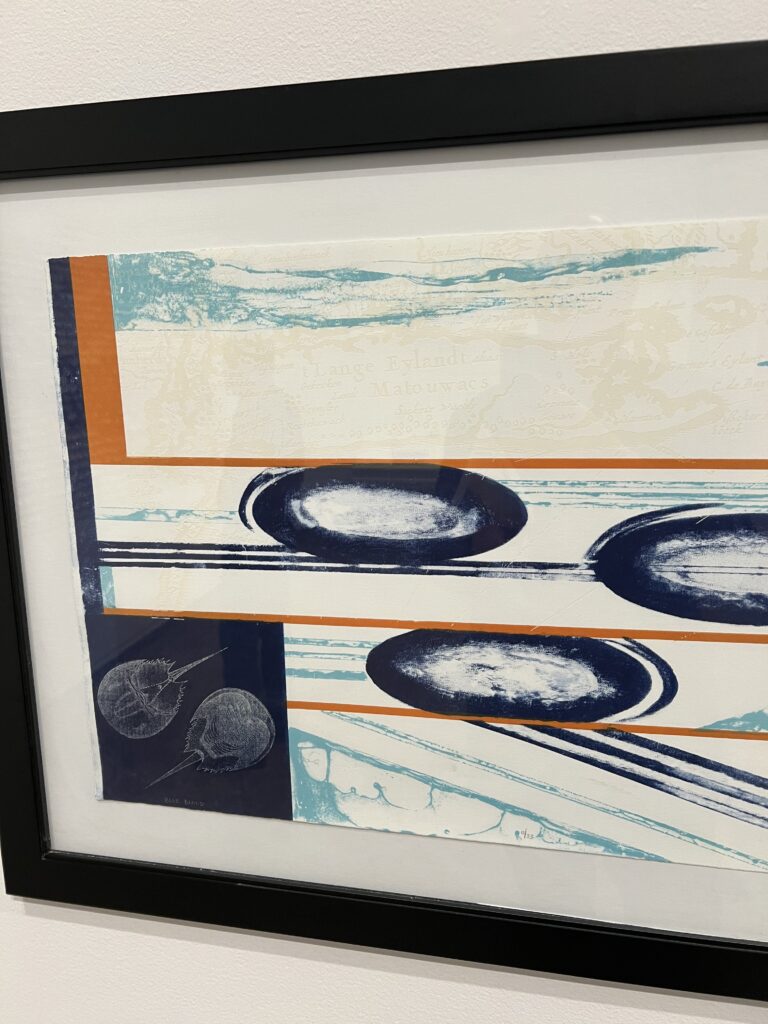Two great events between Long Island and Brooklyn yesterday afternoon. As Friday traffic grew, I drove out to the lovely Heckscher Museum in Huntington to see Courtney Leonard’s mid-career retrospective, Logbook 2004-2023. A few hours and a weissbier later, I saw Annie Dorsen’s Prometheus Firebringer at Theater for a New Audience in Fort Greene. The shared element in both artworks was constraint. Leonard retells the maritime history of the Shinnecock culture and environment mostly through the use of ceramics. Dorsen uses AI, rhymed couplets, and a lecture made entirely of quotations to reimagine Aeschylus’s lost play, in which Prometheus may or may not reconcile with Zeus. In sum – constraints intensify. Two brilliant shows!

Leonard’s Logbook exhibition, which features a restaging of the stunning Breach #2 installation of ceramic sperm whale teeth on a wooden pallet that I’ve previously seen at the Met a few years ago, traces Leonard’s evolution as an artist since her graduation from the Institute for American Indian Arts into her ongoing exploration of her native Shinnecock lands in central Long Island. The retrospective show opens with a call to arms about land alienation:

Can a culture sustain itself when it no longer has access to the environment that fashions that culture?
In addition to Breach #2, the most eye-catching piece in the exhibition is Contact 2, 2023, a map of the Shinnecock lands in what we now call Long Island, composed of ceramic thumbprints that outline the land and sea environment. As Heather Arnet, Director of the Heckscher, describes this work in the published catalog:

Leonard created this expansive map of Long Island by crafting thousands of ceramic thumbprints in the colors of the quahog shell. Each element captures a moment, a memory, a point of contact (4)
Courtney M. Leonard, Logbook 2004-2024
Not all the pieces in this show employ the restraint of ceramic; paintings and other forms of sculpture also appear. A lithograph, Blue Blood 2015, represents horseshoe crabs and their valuable blood, which continues elicit controversy around Long Island Sound today. Leonard links horseshoe crabs, whose blood is used for biomedical research, to the longstanding harvest of whales from Shinnecock waters.

I’ve been amazed by Courtney Leonard’s work since I stumbled across Breach #2 in the Met several years ago. I’m very pleased that Suzanne Conklin Akbari and I will be able to include two images of her Contact 2021, which maps the watershed of the Muhheakunnuk / Hudson river in New York, in the forthcoming Sailing without Ahab.
After a crowded trip down the LIE and a beer with an old friend in Fort Greene, I got to my seat at Prometheus Firebringer just before the show started. That meant I didn’t really have time to look at the online program or think through the complex intellectual architecture of the show. But I think piecing it together on the fly was the best way to experience it.
The pre-opening act was a screen flashing out multiple iterations of possible plots to the lost play Prometheus Firegiver, part of Aeschylus’s Prometheia trilogy about the rebellious Titan who gave fire / technology to humans and was punished by being chained to a rock and having the eagle of Zeus eat his liver daily. This play, third (maybe?) in the trilogy, may describe the reconciliation of the Sky God and the Titan, in the presence of a Chorus made up of human orphans. Or, as the AI-generated scenarios spills it all out, maybe they don’t really reconcile?

The second of three constrained performances in the show was a lecture performed informally by Annie Dorsen, which she admitted was made up entirely of quotations, the sources of which flashed on a screen behind her. After the show, a staff member of Tfana help up a QR code with a link to the lecture and its sources.
The third intertwined performance came from the computerized (or at least inhuman-sounding) voices of the empty masks on stage. One solitary mask speaks for Prometheus, the other half-dozen gathered together for the chorus of orphan children. (Zeus storms, but does not speak.) The oddly moving constraint here is the density of the rhyme, in which almost all statements by the speakers call up answers via a rhymed couplet from the other. Additional internal and half-rhymes aboud. The result sounds awkward, sometimes stilted, but also in places very emotional – even though these speakers are neither controlled by ChatGPT nor by being comprised of quotations. Rhyme is an ancient technology – older than Greek tragedy, to say nothing of generative AI. What can we make inside rhyme’s chains?
There’s just one more week to see Prometheus Firegiver, but Courtney Leonard’s show is up through Nov 12. I might try to drive out to Huntington again to see Leonard’s site-specific installation nearby at Planting Fields Arboretum in Oyster Bay.